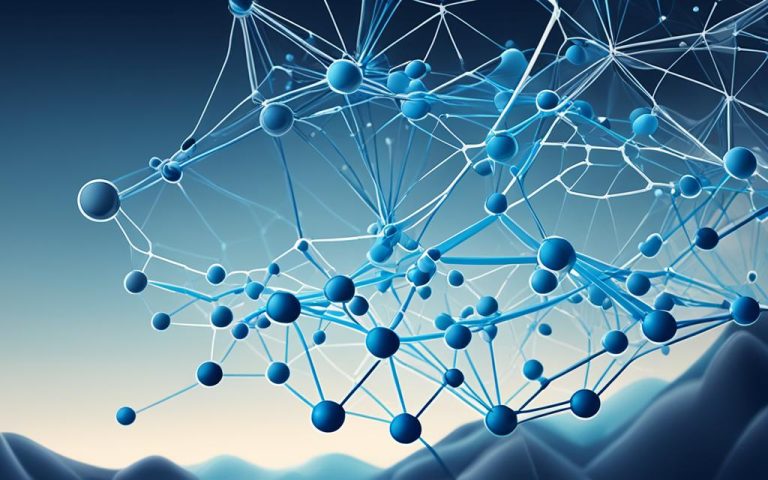In today’s digital landscape, businesses face growing demands for real-time data processing and enhanced performance. Traditional cloud computing architectures often struggle to meet these requirements, as the centralized nature of cloud networks can result in high latency and limited scalability. However, by integrating edge computing into cloud network architectures, organizations can unlock the potential for low latency and quick data processing.
Edge computing, a distributed computing paradigm, brings computational resources closer to the network edge, reducing data travel distances and improving responsiveness. By extending cloud capabilities to remote sites and the network edge, organizations can achieve low latency and enhance performance, ultimately enabling new applications and services.
Integrating edge computing into cloud network architectures is particularly crucial for applications such as retail data analytics, network services, and emerging technologies like smart cities and AR/VR. With edge computing, organizations can analyze large volumes of data in real-time, automate industrial processes, and enhance user engagement through augmented reality integration.
In this article, we will explore the benefits of integrating edge computing into cloud network architectures and how it can revolutionize data processing and application performance. We will also delve into the architectural components and key technologies that underpin low-latency edge applications, as well as the symbiotic relationship between edge computing and cloud computing.
Join us as we uncover the transformative potential of integrating edge computing into cloud network architectures to achieve low latency, improve data processing, and unlock new opportunities for innovation and growth.
The Need for Edge Computing in Cloud Architectures
Modern cloud computing architectures have proven their maturity, resilience, flexibility, and simplicity in meeting various business demands. However, as organizations encounter new requirements and expectations, the limitations of centralized cloud architectures become apparent. High latency and low bandwidth hinder the real-time analytics and automation necessary for industries to thrive.
Edge computing emerges as a solution to these challenges by enabling distributed infrastructure and bringing the computational power closer to the network’s logical edges. By reducing latency and optimizing the efficiency, dependability, and performance of applications and services, edge computing enhances the capabilities of cloud architectures. It empowers organizations to develop new applications, support distributed systems, and handle increased network and application workloads simultaneously.
Edge computing fills the gaps left by centralized cloud architectures, ensuring that businesses can keep up with the evolving demands of today’s digital landscape. It enables real-time analytics, process automation, and seamless integration with emerging technologies.
The Importance of Distributed Infrastructure
A key aspect of edge computing is its distributed infrastructure, which plays a critical role in enabling low-latency operations. By placing computing resources closer to the edge, organizations can significantly reduce the time it takes for data to travel from the source to the processing center. This proximity enhances the responsiveness and efficiency of applications and services, particularly those that require real-time data processing and analysis.
With distributed infrastructure, organizations can overcome the limitations of traditional cloud architectures and unlock the full potential of edge computing. By strategically deploying computing resources at various points in the network, businesses can minimize data transmission distances, optimize bandwidth usage, and ensure the timely availability of critical data.
One example that highlights the benefits of distributed infrastructure is the deployment of edge computing in Internet of Things (IoT) environments. With edge computing, IoT devices can transmit data to nearby edge nodes for real-time processing, minimizing the need for extensive data transmission to centralized cloud servers. This approach not only reduces latency but also enhances data privacy, security, and reliability.
Furthermore, distributed infrastructure enables organizations to achieve scalability and resilience by decentralizing their computing resources. By distributing processing and storage capabilities across multiple edge nodes, organizations can handle increasing workloads and seamlessly adapt to changing requirements without straining centralized cloud infrastructures.
Advantages of Edge Computing in Cloud Architectures
The integration of edge computing into cloud architectures brings forth several advantages for organizations:
- Reduced Latency: Edge computing minimizes the time it takes for data to travel, enabling real-time processing and analytics, and enhancing user experiences.
- Improved Performance: By bringing computational resources closer to the network edge, edge computing enhances the efficiency, dependability, and performance of applications and services.
- Scalability: Edge computing supports distributed systems, allowing organizations to handle increased workloads and seamlessly adapt to changing demands.
- Enhanced Security and Privacy: With edge computing, sensitive data can be processed and stored locally, reducing the risk of data breaches and ensuring compliance with privacy regulations.
- New Applications: Edge computing enables the development of innovative applications that require real-time processing, such as augmented reality, autonomous vehicles, and industrial automation.
By integrating edge computing into their cloud architectures, organizations can harness these advantages and stay ahead in today’s digital landscape.
Advantages of Edge Computing in Cloud Integration
The integration of edge computing and the cloud offers various advantages for organizations seeking real-time solutions and improved industrial automation. By combining the benefits of localized processing with the scalability and management capabilities of the cloud, businesses can unlock new opportunities for innovation and efficiency.
Edge computing allows for time-sensitive applications/software, automating industrial automation and enhancing user engagement.
One of the primary advantages of integrating edge computing into cloud architectures is the ability to develop analytical algorithms and edge computing applications, leading to increased potential for innovation and data-driven decision-making. This integration enables organizations to harness the power of real-time solutions and improve industrial automation processes.
Edge computing ensures offline computing capabilities, allowing critical applications to continue processing data even when connectivity to the cloud is disrupted. This capability is particularly valuable in industries where uninterrupted operations are essential, such as manufacturing, healthcare, and transportation.
Furthermore, edge computing provides additional storage options and enhanced security. By storing data closer to the edge, organizations can reduce data transmission latency and mitigate the risks associated with centralized cloud storage. This approach enhances data privacy and compliance while offering improved performance for applications that rely on data processing at the network edge.
As an example, edge computing enables augmented reality integration into real-world settings, enhancing user engagement and delivering immersive experiences. By processing AR applications locally at the edge, organizations can reduce latency and ensure seamless interactions between digital content and the physical environment.

The advantages of edge computing in cloud integration are summarized in the table below:
| Advantages of Edge Computing in Cloud Integration |
|---|
| Increased potential for innovation |
| Time-sensitive applications and industrial automation |
| Additional storage options |
| Enhanced security |
| Offline computing capabilities |
| Improved user engagement and augmented reality integration |
Integrating edge computing into cloud architectures unlocks a new realm of possibilities for organizations, revolutionizing the way data is processed, applications are developed, and industrial processes are automated.
Understanding Latency and Its Impact on Applications
Latency is a critical performance metric in digital applications, referring to the delay in data processing and delivery. In traditional cloud computing models, latency issues are exacerbated due to data travel distances, bandwidth congestion, and processing delays.
Edge computing reduces latency by decentralizing data processing, bringing computational resources closer to the source of data generation. This approach minimizes data travel distances, improves application responsiveness, and optimizes bandwidth usage. By minimizing the amount of data transmitted to centralized clouds, edge computing enables more responsive and reliable real-time applications.
“Reducing latency through edge computing is crucial for industries such as finance, gaming, and autonomous vehicles. Real-time applications heavily depend on low latency to deliver seamless user experiences and enable near-instantaneous data processing.”
The Impact of Latency:
Latency directly affects the performance of real-time applications and data processing. Here are some key impacts of latency:
- Delayed data delivery
- Poor application responsiveness
- Increased processing time
- Unreliable real-time performance
Benefits of Edge Computing in Reducing Latency:
By leveraging edge computing, organizations can overcome the challenges presented by latency. These benefits include:
- Localized data processing: Edge nodes process data near its point of creation, reducing the distance data needs to travel for processing.
- Reduced network congestion: Edge computing reduces the burden on centralized cloud networks, optimizing bandwidth usage.
- Faster application responsiveness: Real-time applications can leverage edge computing to minimize latency and deliver near-instantaneous responses.
- Improved scalability: Edge computing allows for the distribution of processing resources, enabling applications to scale based on demand.
To illustrate the impact of edge computing on reducing latency, consider the following example:
| Cloud Computing | Edge Computing |
|---|---|
|
|
By adopting edge computing, organizations can significantly improve the performance and responsiveness of their applications. The decentralization of data processing helps minimize latency, enabling seamless real-time experiences for end-users.
Architectural Components of Low-Latency Edge Applications
Low-latency edge applications are designed with specific architectural components to reduce delays and optimize data processing. These components play a crucial role in enabling the seamless and efficient operation of low-latency edge applications.
1. Edge Nodes
In low-latency edge applications, edge nodes act as the first point of contact for data processing. They are strategically placed in close proximity to the data source, ensuring minimal data travel distances and reducing latency. Edge nodes are responsible for processing data at or near its point of creation, allowing for real-time analysis and decision-making.
2. IoT Hubs
IoT hubs play a critical role in aggregating and managing data from various IoT devices. They act as central points for data collection, enabling efficient data processing and analysis. IoT hubs ensure seamless connectivity between edge nodes and IoT devices, facilitating real-time data aggregation and synchronization.
3. Distributed Data Storage
Low-latency edge applications require distributed data storage architectures to ensure data is stored in proximity to its usage. By storing data closer to the edge nodes, the need for data retrieval from distant storage locations is minimized, resulting in reduced latency and improved application performance.
4. Localized Decision-Making and Analytics
Localized decision-making and analytics capabilities are essential components of low-latency edge applications. By decentralizing decision-making and analytics processes to the edge, real-time processing and intelligent decision-making can be achieved. This allows for faster response times and enables adaptive, context-aware applications.
5. Orchestration and Management Tools
To ensure efficient utilization of resources and seamless operation of low-latency edge applications, orchestration and management tools are employed. These tools automate essential tasks such as resource allocation, load balancing, and service management. By streamlining operations, orchestration and management tools contribute to the overall optimization of low-latency edge applications.
Utilizing these architectural components, low-latency edge applications can achieve optimal performance, reduced latency, and enhanced data processing capabilities. Edge nodes, IoT hubs, distributed data storage, localized decision-making and analytics, and orchestration and management tools collectively form the backbone of low-latency edge applications.
Key Technologies and Protocols for Low-Latency Operations
Low-latency edge applications rely on a combination of advanced technologies and protocols to enable rapid data processing, efficient communication, and robust security. These key technologies and protocols form the backbone of low-latency edge computing systems, enabling swift and secure data processing. Let’s explore some of these critical components:
1. 5G Networks
5G networks are a key enabler for low-latency operations, providing faster data transfer rates and reduced latency compared to previous generations. With 5G, edge computing applications can benefit from real-time communication, enabling seamless interactions and immediate response times.
2. MQTT (Message Queuing Telemetry Transport)
MQTT is a lightweight messaging protocol designed specifically for IoT devices. It allows for efficient and reliable communication between edge devices and the cloud, facilitating the exchange of data required for low-latency operations. MQTT’s lightweight design minimizes network bandwidth usage while ensuring real-time data transmission.
3. WebRTC (Web Real-Time Communication)
WebRTC is a technology that enables real-time communication in web browsers and mobile applications. It allows for direct communication between edge devices and eliminates the need for intermediate servers, reducing latency and enhancing the overall user experience. WebRTC plays a crucial role in enabling low-latency operations in real-time applications.
4. Edge Orchestration Platforms
Edge orchestration platforms play a vital role in managing distributed edge computing infrastructures. These platforms provide the necessary tools and frameworks for deploying, managing, and scaling edge applications. They ensure efficient resource utilization, enable seamless integration with cloud services, and optimize data processing and communication for low-latency operations.
5. AI and Machine Learning at the Edge
AI and machine learning algorithms deployed at the edge enable localized decision-making and advanced analytics. By processing data closer to the source, edge devices can perform real-time analysis and make intelligent decisions without relying solely on the cloud. AI and machine learning capabilities at the edge enhance the overall performance and responsiveness of low-latency operations.
6. Security Protocols
Security protocols, such as Transport Layer Security (TLS) and IP Security (IPSec), are crucial for ensuring secure data transmission in low-latency edge applications. These protocols establish secure channels for data exchange, encrypting and securing data as it travels between edge devices and the cloud. Robust security protocols protect against potential threats and vulnerabilities in low-latency operations.
By leveraging these key technologies and protocols, low-latency edge applications can achieve rapid data processing, efficient communication, and robust security. These components work together to enable the seamless integration of edge computing into cloud architectures, unlocking the full potential of low-latency operations.
Understanding the Relationship Between Edge Computing and Cloud Computing
Edge computing and cloud computing are not competing technologies, but rather complementary. By understanding their relationship, organizations can harness the benefits of both technologies to optimize efficiency and performance.
Edge computing extends the functionality of the cloud by addressing latency and bandwidth constraints, enhancing data privacy and security, and enabling immediate data analysis.
The cloud computing model provides centralized resources for heavy-duty processing and analytics. On the other hand, edge computing handles local, time-sensitive processing and reduces the need for data transmission to the cloud.
By integrating both technologies, organizations can create a comprehensive computing framework that leverages the strengths of each. The cloud provides scalability, storage capabilities, and robust infrastructure for intensive computational tasks, while edge computing enables quick data processing, real-time analytics, and localized decision-making.
“Edge computing and cloud computing are like two sides of the same coin. They work together seamlessly to deliver the best of both worlds – centralized resources and local processing power.” – [Industry Expert]
The relationship between edge computing and cloud computing is symbiotic, allowing organizations to optimize their IT strategies and cater to the diverse needs of modern applications. This integration offers a range of benefits, including:
- Reduced latency: Edge computing brings computational resources closer to the point of data generation, minimizing data travel distances and improving application responsiveness.
- Enhanced performance: Edge computing enables real-time processing and analytics, leading to increased efficiency and improved user experiences.
- Improved data processing: Cloud computing provides scalable storage, processing capabilities, and advanced analytics to handle large volumes of data, while edge computing handles immediate data analysis and localized processing.
- Increased scalability: By combining the scalability of the cloud with the agility of edge computing, organizations can scale their applications and services as needed, without compromising on performance.
By understanding the complementary nature of edge computing and cloud computing, organizations can make informed decisions about their IT architectures and embrace the benefits of these complementary technologies.
Edge Computing and Cloud Computing: A Comparison
| Edge Computing | Cloud Computing |
|---|---|
| Local, time-sensitive processing | Centralized processing and analytics |
| Reduces latency | Allows heavy-duty processing |
| Enhances data privacy and security | Provides robust infrastructure and storage capabilities |
| Enables immediate data analysis | Offers advanced analytics and insights |
Conclusion
Integrating edge computing into cloud network architectures brings a multitude of benefits to organizations, allowing them to optimize their IT strategies and drive digital innovation. By leveraging the architectural components of low-latency edge applications, businesses can achieve reduced latency, enhanced performance, improved data processing, and increased scalability.
The symbiotic relationship between edge and cloud computing creates a powerful computing environment that caters to the diverse needs of modern applications. This integration enables organizations to achieve real-time automation, capture and analyze data more effectively, and accelerate the adoption of cloud computing in traditional facilities.
With edge computing integration, businesses can harness the power of localized processing at the network edge, bringing cloud capabilities closer to remote sites. This not only reduces latency but also enables quick data processing, improved performance, and enhanced user engagement. By combining the scalability and management capabilities of the cloud with the benefits of edge computing, organizations can meet changing expectations, enable new applications and services, and drive digital transformation.
FAQ
What is edge computing?
Edge computing is a distributed computing paradigm that brings computational resources closer to the network’s logical edges, reducing latency and improving the efficiency, dependability, and performance of applications and services.
Why is edge computing necessary in cloud network architectures?
Edge computing is necessary in cloud network architectures to address the limitations of centralized cloud computing, such as high latency and low bandwidth. It allows for low latency, quick data processing, and improved performance, enabling real-time analytics, automation of industrial processes, and the integration of emerging technologies.
What are the advantages of integrating edge computing into cloud architectures?
Integrating edge computing into cloud architectures offers various advantages, including increased potential for innovation, time-sensitive applications/software, additional storage options, enhanced security, offline computing capabilities, and augmented reality integration into real-world settings.
What is latency and how does edge computing reduce it?
Latency refers to the delay in data processing and delivery. Edge computing reduces latency by decentralizing data processing, bringing computational resources closer to the source of data generation. This approach minimizes data travel distances, improves application responsiveness, and optimizes bandwidth usage.
What are the architectural components of low-latency edge applications?
The architectural components of low-latency edge applications include edge nodes, IoT hubs, distributed data storage, localized decision-making and analytics, and orchestration and management tools. These components enable processing data at or near its point of creation, aggregating and managing data from various IoT devices, storing data in proximity to its usage, enhancing real-time processing and intelligent decision-making at the edge, and automating essential tasks.
What are the key technologies and protocols for low-latency operations?
The key technologies and protocols for low-latency operations include 5G networks, MQTT for lightweight IoT messaging, WebRTC for real-time communication, edge orchestration platforms for managing distributed edge computing infrastructures, AI and machine learning for localized decision-making and analytics, and security protocols like TLS and IPSec for secure data transmission.
How does edge computing relate to cloud computing?
Edge computing and cloud computing are complementary technologies. While cloud computing provides centralized resources for heavy-duty processing and analytics, edge computing handles local, time-sensitive processing and reduces the need for data transmission to the cloud. Integrating both technologies creates a comprehensive computing framework that optimizes efficiency and performance.
What are the benefits of integrating edge computing into cloud network architectures?
Integrating edge computing into cloud network architectures offers benefits such as reduced latency, enhanced performance, improved data processing, and increased scalability. It enables organizations to optimize their IT strategies, embrace digital innovation, achieve real-time automation, capture and analyze data effectively, and accelerate the adoption of cloud computing in traditional facilities.



















